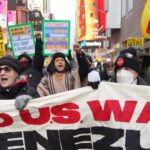
Article from the famous magazine The Cradle responds: the death of Yahya Sinwar, strategic leader of Hamas, opens a new chapter in Palestinian resistance; find out how this martyrdom can impact the fight.
The martyrdom of Yahya Sinwarthe powerful and intelligent leader of Hamas and “architect” of Operation Al-Aqsa Flood, which died fighting invading Israeli forces on the front lines in Rafah, marks a pivotal moment in the history of the Israeli occupation of Palestine. As one of the movement’s most prominent military and strategic leaders, Sinwar was for a long time a main target of the Israeli occupation forces.
For years, he was Israel’s most sought-after figure, due to his key role in advancing the resistance’s capabilities and orchestrating strategic operations — particularly the recent enchente of Al-Aqsawhich led to the deaths of more than 1,500 Israeli soldiers and settlers and the capture of more than 200 othersthe majority still maintained by Qassam Brigades.
With the last heroic stand of Sinwar On the battlefield of Gaza, Hamas faces unprecedented leadership and continuity challenges. The targeted assassinations of senior leaders by the Israeli occupation — Ismail Haniyeh is a Teerã, Saleh al-Arouri in Beirut and now, accidentally, Yahya Sinwar in Gaza — created a leadership vacuum that threatens the movement both at home and abroad. Furthermore, Hamas’ long-standing ties to the Iranwhich were strained due to the war in Syria, were also solidified under the supervision of Sinwar.
Filling the void left by Sinwar
To deal with this crisis, Hamas has several options. The first involves selecting a new leader from among its prominent figures. Khalil Al-Hayya, Khaled Meshaal e Zaher Jabareen are among the most likely candidates. The reports also shed light on Sinwar’s younger brother, the senior commander of Qassam, Muhammad Sinwar. However, Israeli media outlets speculate that he is not being considered for the post of head of the politburo, but could take on the role of maximum leader in the Gaza Strip.
HayyaSinwar’s deputy in Gaza, is a strong candidate for leadership. He has considerable support within Hamas, heads the Office of Arab and Islamic Relations and maintains strong ties with the Iran and the Egypt.
Meshaala founding member of the politburo and survivor of an assassination attempt ordered by the Israeli prime minister Benjamin Netanyahualso has extensive international relations and political influence. Although he previously announced he would not return to leadership, there are growing calls for his renaming amid the current crisis. However, future relations with Syria and Iran may be questioned under his skeptical leadership and support for the Syrian opposition.
Zaher Jabareena founding member of the armed wing and leader of Hamas in the occupied West Bank, is another key figure. He has a long history of struggle and is seen as an influential force within the movement. This is significant because strengthen resistance of the West Bank has been an ambition of Islamic Republic of Iran as part of its support for the Palestinian liberation struggle.
Collective leadership as a viable strategy
Another option for Hamas is to adopt a collective leadershipavoiding the concentration of power in a single figure to minimize risks amid ongoing assassination threats. This looser structure could help spread the burden of leadership, making it more difficult for Israel to decapitate movement, as recently experienced by the Hezbollah do Lebanon.
A third path involves trusting the movement’s internal institutions, such as the Shura Council. Currently led by Abu Omar Hassan Darwishthe Shura Council could provide a stable, institutionalized leadership model that also focuses on collective decision-making.
Despite the challenges, Hamas has a strong organizational structure and institutions capable of making appropriate decisions in the absence of such a crucial and experienced leader as Sinwar.
On the day of Yahya al-Sinwar
The trajectory of Yahya al-Sinwar in Hamas began in the mid-1980s, when he established the movement’s security wing, called “Then”under the supervision of the late founder, Sheikh Ahmed Yassin. Sinwar met with Yassin, asking for support for the movement to confront the Israeli occupation, and declared: “We will fight this, even with dirt.”
That unwavering dedication resistance made him a close confidant of the movement’s spiritual leader, and he began to form the nucleus of Hamas’s military wing, which later developed into the Qassam Brigades.
In 1988, coinciding with the outbreak of First IntifadaSinwar was arrested and sentenced to life imprisonment, but despite his detention, he played an active role in exposure of agents. Sinwar spent more than 22 years in Israeli prisons, being released in 2011 in a prisoner exchange agreement known as “Loyalty of the Free”which included the release of the Israeli soldier Gilad Shalit in exchange for more than 1,000 Palestinian prisoners.
Sinwar’s strategic leadership
After his release, Sinwar took on new responsibilities, the most important of which was his defense of Qassam Brigades on the Hamas Executive Committee, acting as the equivalent of the Ministry of Defense of the movement.
This phase was transformative, as Sinwar began to lay the foundations for a comprehensive strategy which included the development of tunnel networkone of the strategic weapons of the resistance, and the improvement of missile and anti-armor systemwhich proved effective in confronting Israeli forces.
He also contributed to the establishment of Nukhba Force (“elite”), designed for offensive operations behind enemy lines. One of his greatest achievements was overseeing operations during the 2014 war, when Nukhba carried out dozens of operations successful operations within the occupied territories.
In 2017 and 2021, Yahya Sinwar was elected head of Hamas in the Gaza Strip, focusing on three strategic pillars: strengthening military capabilities of the movement, seek the Palestinian internal reconciliation and strengthen relations with the Egypt and other regional powers.
Closer to the Axis of Resistance
Despite the Israeli repression of unarmed marches of the “Great Return”Sinwar achieved advances, such as the opening of Rafah pass and the partial relief of the siege, improving living conditions in Gaza.
During his period at the head of Hamas’ military wing, Sinwar strengthened ties with the Axis of Resistanceespecially with the Hezbollah and the Iranensuring significant military and logistical support.
A Al-Aqsa flood It was the largest military offensive in the history of the Arab-Israeli Conflict. Israeli authorities believed that Hamas had succumbed to the blockade, but Sinwar had meticulously planned the attack for years, causing heavy losses and captures for Israel.
The end of one era, the beginning of another
Amid contradictory reports about his last moments, “The fact that he was killed in combat uniform and after shooting at Israeli soldiers, attacking a drone with a wooden bat, distinguishes Sinwar from his predecessors who were murdered while fleeing”observe the Guardian.
While the Wall Street Journal states that “in death, the leader of Hamas may have gained more support than in life”Sinwar’s martyrdom is undoubtedly a significant blow, but it marks an honorable end for a leader who became synonymous with firmness, dedication and resistance. Under his leadership, Hamas emerged as a central actor in the Palestinian struggle, increasing its military capabilities and returning the Palestinian cause to the international stage.
Sinwar’s death is not only the end of a visionary commander’s life, but the beginning of a new chapter for Hamas and the Palestinian resistance as a whole. As the Palestinian people face a existential struggleHamas reemerges as a fundamental member at the forefront of Axis of Resistance in Western Asia.
The movement now faces the crucial challenge of maintain your cohesionresist Israeli offensives and protect its people in the face of an intensified campaign of aggression.
Source: https://www.ocafezinho.com/2024/10/22/o-que-a-morte-de-sinwar-significa-para-o-futuro-do-hamas/

